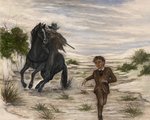Wind: 0.0 mph, N
Welcome to our new web site!
To give our readers a chance to experience all that our new website has to offer, we have made all content freely avaiable, through October 1, 2018.
During this time, print and digital subscribers will not need to log in to view our stories or e-editions.



“Chalk Hill” is a story that began with two Alamogordo brothers and wound up as a screenplay about a father and son who have become part of the history and lore of southern New Mexico and the Old West.
State Sen. Ron Griggs of Alamogordo was always fascinated by a book he read at his grandparents’ house about the disappearance of Albert J. Fountain and his 8-year-old son, Henry, in the late 19th century near where he and his brother, Jeff, grew up.
Ron suggested to Jeff, a professional actor, that he turn the story into a screenplay. Jeff, who lives in Los Angeles, with acting credits that include television series, movies and a Southwest Airlines TV commercial that is now airing, liked the idea.
After five years of research and writing, Jeff completed the screenplay earlier this year and is partnering with the New Mexico State University Theatre Department on a staged reading in Las Cruces this month.
“Chalk Hill” is the title of Griggs’ screenplay, and the name of the site near White Sands Missile Range where the 1896 murders likely took place. It’s an area the Griggs brothers knows well, having explored it many times over the years.
In fact, it was Ron Griggs who connected his brother with NMSU Theatre Department Head Wil Kilroy.
“I thought this was a great opportunity for our students to work with a professional coming in from Los Angeles, and to be exposed to a screenplay that is planned for filming in this area in the future,” Kilroy said. “In addition to our students, there will be actors from Las Cruces and El Paso,” Kilroy said, and Griggs is bringing professional actors from Los Angeles to read some parts.
The “Chalk Hill” cast of characters includes people who were involved in the murders and their investigation, including Old West icons like Pat Garrett and Billy the Kid, both the Fountains and their alleged murderers, rancher Oliver Lee and his employees Jim Gililland and Billy McNew; Lee and Gilliland were found not guilty of the murder of Henry Fountain in an 1899 trial held in Hillsboro, New Mexico. They were defended by Albert Fall – another real-life character in the screenplay – who would become one of New Mexico’s first U.S. senators and later spend a year in federal prison for his involvement in the Teapot Dome scandal during the Harding administration.
Fall had a lot of influence in the courts, Griggs said, and Lee was a powerful cattle rancher who would become a state senator and have a state park named after him.
In his research, Griggs said he learned that Lee publicly said he had never killed a man who didn’t deserve killing.
“That’s a fascinating thing for someone to say,” Griggs said. Lee was “okay with taking another man’s life, okay with being judge, jury and executioner,” he said.
“They didn’t call it the Wild West” for nothing,” Griggs said. At the time of the Fountain murders, New Mexico Territory, he said, was “kind of like Al Capone’s Chicago.”
Griggs said people were especially outraged about the Fountain murders because one of the victims was a child.
Territorial Gov. William Taylor Thornton knew the murders wouldn’t help New Mexico’s efforts to become a state, Griggs said. He brought Doña Ana County Sheriff Pat Garrett into the investigation in 1898, and Garrett “did what he could to bring justice to this egregious crime,” Griggs said.
The bodies of Fountain and his son were never found and no one was ever convicted of their murders. But bringing attention to the crime, “doing what we could to hold men accountable for their actions, we suggested to the rest of the world that we had a level of stability and could govern ourselves,” Griggs said.
“Finding the humanity in these characters” was one of Griggs’ goals in writing the screenplay, he said. He drew from historical documents “to develop characters,” while others were based on Griggs’ father and grandfather, whom he called “the most honorable men I knew.”
“Chalk Hill,” Griggs said, is “a period piece that takes place on the incredible canvas of southwest New Mexico.” The site “lends itself to the most extraordinary cinematography,” he said. “It’s just one of the most beautiful, breathtaking places ever.”
Griggs last scouted Chalk Hill with Ron in September, he said, watching the sun going down behind “the gray-blue giants of the Organ Mountains (with) a gigantic moon over Dog Canyon,” as he imagined Fountain and his son riding through in a buckboard.
Griggs is a graduate of NMSU, where he was mentored by Tony award winner Mark Medoff. Another career influence is Oscar-winning cinematographer Janusz Kamiński, whom Griggs met when they worked together on location on a movie in Moscow, Russia.
Developing “Chalk Hill” into a motion picture, Griggs said, is allowing him to use everything he has learned in filmmaking “to do the best work I’ve ever done.”
Other items that may interest you
